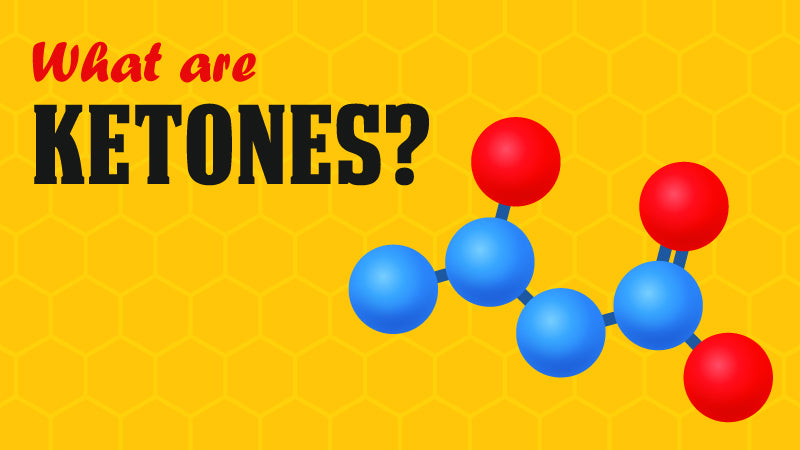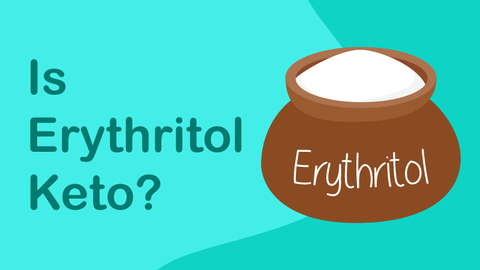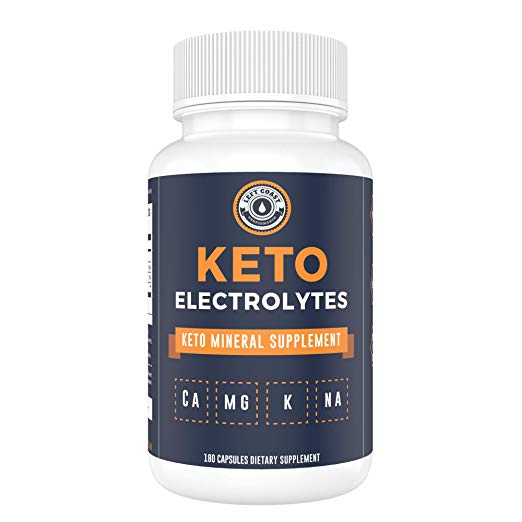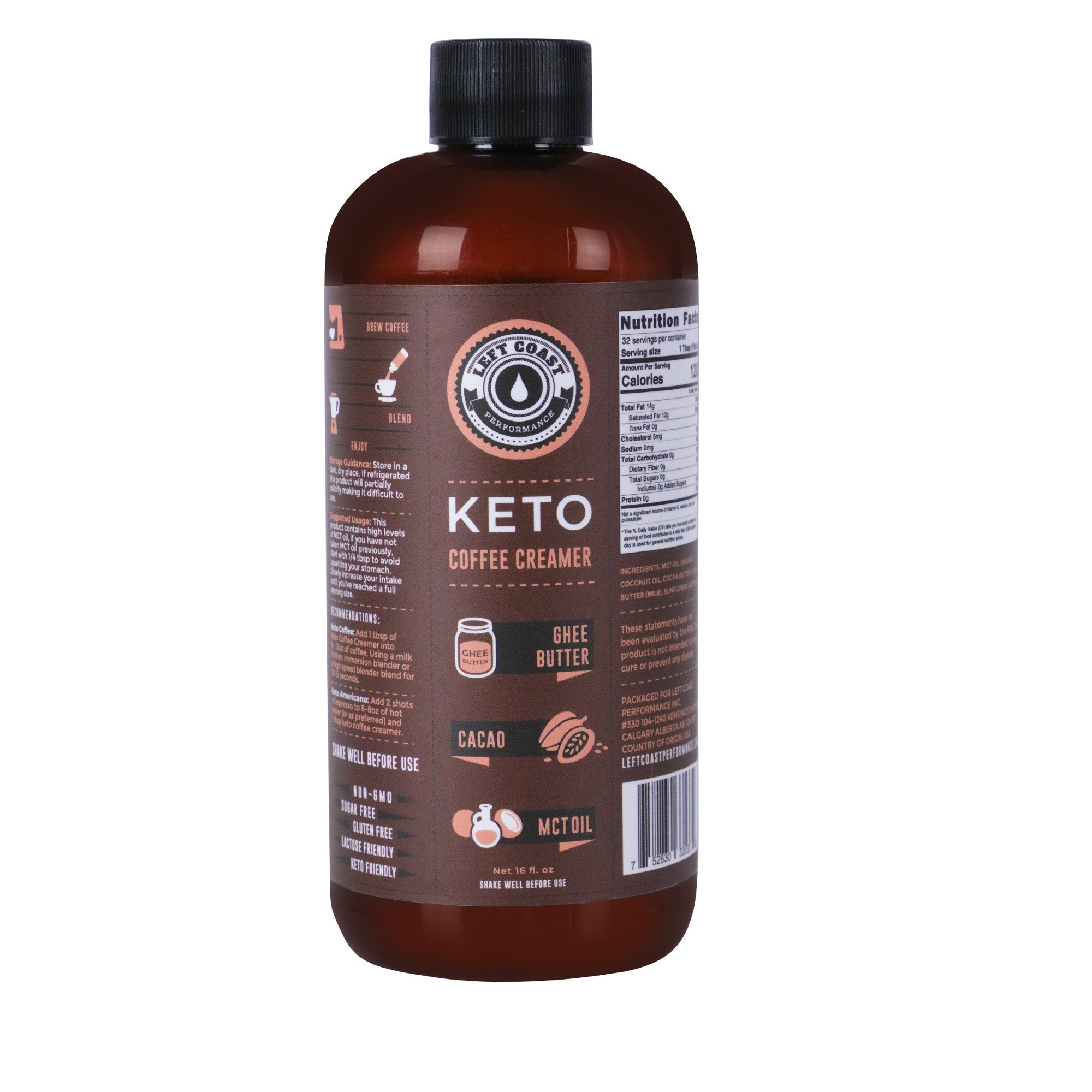What Are Ketones?

on August 21, 2019
The body uses two types of fuel for energy - either glucose or ketone bodies. When you consume a diet with a moderate amount of carbohydrates, the body will use glucose as the main energy source for most tissues.
But, when you begin to eat ketogenic diet with very few carbohydrates or during periods of fasting, the body begins to use ketones for energy instead. There is a lot of misinformation about ketones and what they are exactly, so let’s take an in-depth look.
What Are Ketones?
Ketones, also called ketone bodies, are the byproducts of breaking down fat for energy. This happens when there are not enough carbohydrates to meet the body’s energy needs.
The state of breaking down ketones for energy instead of carbs is called ketogenesis. Relying primarily on ketones for energy is called ketosis. This can happen when you haven’t eaten enough carbs (following a ketogenic diet), when you are fasting, or during prolonged exercise. Ketosis can also happen during pregnancy.
But, contrary to popular belief, ketogenesis is happening in small quantities all the time. After an overnight fast about 2-6% of the body’s energy comes from ketone bodies, after a three day fast, 30-40% of energy needs are met by ketones.
The purpose of ketones is to keep your body fuelled even in the absence of calories or carbohydrates. The process of using fat as fuel is called beta-oxidation and occurs in the mitochondria. Beta-oxidation is occurring all the time, not just when you are in ketosis. There are certain tissues that prefer to run on energy from fat.
There is almost an unlimited amount of energy that can be made from stored fat through this process. This is why fasting for short periods isn’t detrimental. Your body was designed to do so.
What Are Ketone Bodies?
There are three ketone bodies:
- Acetoacetate
- Beta-hydroxybutyric acid (BHB)
- Acetone
Acetoacetate and BHB are the primary ketone bodies. All three ketones are made in the liver, then enter the bloodstream in order to travel to other organs in the body that need energy. They will always travel to the brain first because it is the most important organ.
The ketones will be used for energy where they are needed, then excreted primarily via the urine. The presence of ketones in the urine is called ketonuria. Acetone can be excreted via the lungs. This is why a side effect of ketosis is fruity-smelling breath, this is from the excretion of the acetone.
Ketone bodies are present in the body all the time in varying quantities. For most healthy people, ketones are just part of normal metabolism. They are not dangerous and do not cause any complications as part of a healthy metabolism. When all systems are operating normally, the body is able to utilize them and excrete them as needed.
When the body is able to effectively use ketones for energy, many report an increase in mental performance and physical energy. This may be due to the unlimited amount of calories that is stored in the body’s fat cells and that the body no longer needs constant refuelling from carbohydrates to maintain energy.
But, in certain metabolic situations, ketone bodies can be dangerous. Extremely low insulin levels and high levels of other hormones caused by uncontrolled diabetes can lead to excess production of blood ketones. This state is called metabolic ketoacidosis. This condition is extremely dangerous and even deadly if not treated immediately.
Testing Ketone Levels

If you are following a ketogenic diet, it may be useful to know whether you are in ketosis. This will require you to test the ketone levels in your urine, blood, or breath that can indicate the amount of ketones in your blood. Knowing if you are in ketosis can help you modify your diet by increasing or decreasing carbohydrates to help you reach your goals.
In general, these are the guidelines for ketone levels:
- Not in ketosis: less than 0.6 mmol
- Low to moderate: 0.6 to 1.5 mmol (where ketosis begins)
- High: 1.6 to 3.0 mmol
- Very high: greater than 3.0 mmol
This scale can vary slightly depending on the type of test as well. Therefore, it is best to use the numbers that the testing kit you are using provides.
For healthy people following a ketogenic diet, it is best to test once a day in the morning. For people with diabetes, your doctor will recommend how often you should be testing for ketones in your urine.
There are a few ways to test your ketone levels. The accuracy between these tests can vary. Here are a few of the most popular ways to test for ketones:
Ketone Test Strips
The most popular and cost-effective way to test for ketones is with at-home testing kits that can be bought in almost any drugstore or online. These testing kits include a set of strips that can be placed in the urine stream and based on the color of the strip can indicate a high level of ketones, protein, or glucose.
Test strips are the least accurate method for testing ketones. Results can be skewed based on the time you have been in ketosis, by certain medications, and hydration status. Yet, it really is the simplest way to get started with ketone testing.
Blood Glucose Meters
Many blood glucose meters are also able to test for ketones. This is the most accurate method of testing, but the meters and supplies can be expensive. If you do not have diabetes, it is unlikely these meters will be covered by insurance.
In order to test your blood, you will need to use a lancet to draw a small blood sample from your finger tip. Many meters come with a lancet pen that makes drawing blood relatively painless. The blood is then applied to a test strip attached to the meter. Results show up in seconds. Unless you are doing some serious biohacking of your diet or have diabetes, it is probably unnecessary to use a blood meter to test your ketones.
Ketone Meter Breath
A newer option for testing for ketones is to use a breath meter. This will measure the amount of acetone on your breath. It is simple to use, you just breathe into the meter. The meters are also inexpensive, averaging about $50. The reliability of these meters is questionable, but they are likely more accurate than urine strips.
The method you choose depends on how accurate you need to be. For most people following a keto diet for weight loss or health benefits, the urine strips are probably adequate for knowing if you are in ketosis or not.
Endogenous Vs. Exogenous Ketones
You may have seen some products on the market called exogenous ketones, that are designed to help you get into ketosis faster. Basically, exogenous means ketones coming from outside the body, whereas endogenous ketones are those that are made by the body.
Exogenous ketones are marketed as a “hack” to help you get into ketosis faster or to provide fuel during periods of fasting. These products usually contain acetoacetate and/or BHB. In theory, they can put you into ketosis without following a low carbohydrate diet by elevating blood ketone levels.
Although using exogenous ketones may be a way to help your body get into ketosis faster, using them without diet changes, will not provide the health benefits you might be seeking with a keto diet. They won’t lead to weight loss or blood sugar improvement, if you are still eating carbohydrates.
That being said, you may want to consider using exogenous ketones to help ease the symptoms of the keto flu when you are first getting started. Or if you want to practice intermittent fasting, they can help maintain energy as well, similar to MCT Oil.
The two types of exogenous ketones found on the market are:

-
Ketone salts. BHB bound to some type of mineral salt or amino acid that can be added into liquid. These may contain high amounts of sodium, magnesium, or potassium above the recommended daily allowance.
- Ketone esters. Liquid form of BHB or acetoacetate bound to a ketone ester. These do not have high mineral content and are quite effective at raising ketone levels. They are frequently used to improve exercise performance during endurance training.
There are anecdotal accounts that exogenous ketones will help with mental clarity and increased energy, but research still needs to evaluate these claims. The bottom line is that exogenous ketones can be a tool for those just starting a keto lifestyle or for athletes who need longer-lasting energy.
Can I take Exogenous Ketones Before Bed?
It is not dangerous or problematic to take exogenous ketones at any time. But, you won’t get the benefits of additional energy or mental clarity if you are asleep when they kick in. If you want to optimize your results you may want to take exogenous ketones at specific times depending on your goals.
For energy, consider taking the ketones on an empty stomach or before a workout. This will allow your body to utilize them the most effectively and give you an energy boost.
If you are trying to avoid the keto flu by taking exogenous ketones, consider taking them in small doses throughout the day to prevent some of the uncomfortable symptoms. They may also be helpful if you fall off the “keto wagon” helping you get back into ketosis quickly.
Dangers of Exogenous Ketones
Exogenous ketones themselves are not dangerous on their own. But, there are no long-term studies on the side effects of exogenous ketones, therefore it is best to proceed with caution.
Ketone salts contain high doses of mineral salts such as sodium, magnesium, or potassium. Depending on how much exogenous ketones you take, you could end up overdoing it on minerals. Too much of these minerals can elevate blood pressure or throw off electrolyte balance.
For some people exogenous ketones may cause stomach discomfort, like diarrhea, nausea, or gas. This is why it is better to start slow if you are planning on taking them.
For most healthy people exogenous ketones in normal doses are not a concern and may help you feel more energetic and get into ketosis faster.
Ketones and Diet

In order to switch into using ketones for energy, you must reduce the amount of carbohydrates in your diet. The amount of carbs you can eat to get into ketosis will depend on individual tolerance.
Most commonly, the goal is to eat between 20 to 50 grams of net carbs a day. The macronutrient breakdown of a classic keto diet is 75% of calories from fat, 20% protein, and 5% carbohydrates. If you are extremely active, you may be able to achieve ketosis with more carbohydrates.
In order to keep your carbohydrates so low, you will need to completely eliminate almost all the carbohydrates in your diet, forcing your body to switch to using ketones for energy instead. This means eliminating:
- Grains: oats, quinoa, rice, etc.
- Foods made with sugar: candy, cookies, cakes, pies.
- Sugar-sweetened beverages
- Starches: bread, pasta, cereals.
- Most fruits (berries are allowed in small quantities)
- Beans and legumes
- Starchy vegetables, like potatoes, corn, peas
- Milk and yogurt
The ketogenic diet includes:
- Meat, poultry, fish
- Fats: coconut oil, butter, ghee, olive oil
- All non-starchy vegetables
- Nuts and seeds. in moderation
- Small quantities of berries
- Eggs
- Avocado
- Cheese
- Sour cream
- Heavy cream
- Unsweetened Greek yogurt
After about a week of strict carbohydrate elimination, the body will naturally start to use ketones for energy. After about two weeks is when people report less hunger, more energy, and weight loss on a ketogenic diet.
Ketone Side Effects
When the body first starts to switch to using ketones for energy instead of glucose, you may experience some side effects commonly referred to as the “keto flu”. These include:
- Weakness
- Headaches
- Fatigue
- Brain fog
- Irritability
- Dizziness
These symptoms are not due to the ketones themselves, but the metabolic and hormonal shift that is occuring. These symptoms usually resolve within a few days after your body adapts. Taking exogenous ketones, electrolytes, and staying hydrated can help.
Ketosis Safety
There is some misunderstanding, even among health professionals, about the safety of ketosis. The issue is that ketosis is commonly confused with the extremely dangerous condition called ketoacidosis, but it is not the same.
As we discussed, the body makes ketones all the time as an alternative energy source. When insulin is present, it naturally regulates the amount of ketone bodies in the blood preventing them from building up. Insulin encourages certain tissues to switch over to using ketones for energy instead of glucose when there are too many ketones in the blood. This means that for people without insulin problems, ketosis poses no danger.
But, in the case of people who do not have adequate insulin to regulate ketone bodies, excessive ketones can quickly lead to a dangerous metabolic shift called ketoacidosis. This can occur in alcoholics or during prolonged starvation, but it is most common in people with diabetes, especially type 1.
Without insulin, glucose is unable to enter the cells and remains in the bloodstream, so blood sugar is extremely high. But, the body believes there isn’t enough glucose for energy, so it starts to make large amounts of ketones. Ketone bodies are highly acidic and when they are not regulated, they can alter the delicate pH of the body. Eventually, this leads to metabolic acidosis.
Metabolic acidosis is life-threatening if not treated immediately. Symptoms include confusion, respiratory distress, vomiting, swelling of the brain, and coma. Ketoacidosis must be treated immediately and usually hospitalization is required.
The bottom line is ketones, under normal metabolic conditions, are pretty useful. They sustain our energy while we are sleeping or fasting, so we don’t have to wake up in the middle of the night to eat.















